Best Cambodia travel tips and advice
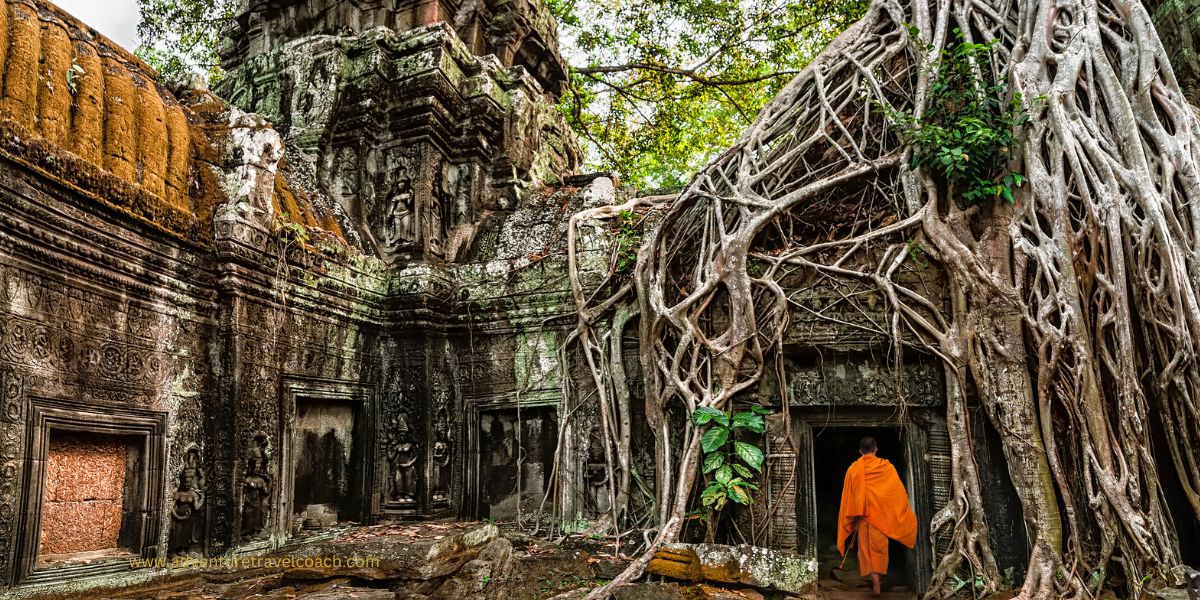
The captivating destination of Cambodia is where the ancient and modern worlds collide, leaving you with a sense of wonder. With its rich cultural history, abundant and extraordinary places, and beautiful islands, Cambodia is a fascinating gem you do not want to miss. From the astounding temples and charming smiles of young monks to the fascinating villages, there is much to explore and enjoy on the Kingdom’s shores. I created a Cambodia Trip Planning Guide after a wonderful visit to this fascinating country. This Cambodia Travel blog guide contains our best tips for planning the perfect trip, including when to go, where to stay, and what to pack. Additionally, insights into Khmer culture, religion, and traditions help you to create a perfect itinerary. With this guide, you can enjoy exploring Cambodia without worrying about anything.
Cambodia at A Glance
Located in Southeast Asia, Cambodia borders Thailand, Laos, and Vietnam. Besides the astonishing Angkor Wat temples, Cambodia is known for its astonishing temples and the devastating Cambodian Civil War between 1970 and 1975. Unfortunately, the victory of the Khmer Rouge, led by Pol Pot and backed by North Vietnam, China and the Vietcong, led to the brutal killing or starving to death of nearly a quarter of Cambodians. Is Cambodia worth visiting? Absolutely Yes!
What you need to know before visiting Cambodia
Language: Khmer is the official language of more than 90% of the population, although the dialect may vary slightly between the regions. Time: Cambodia runs at GMT +7 hours, in the same time zone as their neighbouring countries, Thailand and Laos.
Culture: Family and relationships hold a significant place in Cambodians’ lives. Known for their hospitality and peaceful nature, you will soon realize that anger doesn’t go well here. The Khmers are gentle and kind throughout the Country.
Religion: About 93% of the population practices Buddhism as their primary religion. People must remove shoes and head coverings when entering temple buildings. Buddhists believe it is contrary to a monk’s sacred vows to be near a woman unless she is a relative.
Safety: Cambodia is generally a very safe country with friendly locals. Although we always felt safe during our visit and never had an incident, be cautious and keep your belongings close to you. Incidents of bag snatching, especially from open tuk-tuks, occur especially in big cities like Phnom Penh. However, don’t let these incidents deter you from visiting this wonderful Country. Moreover, don’t wander off the beaten path as the country is still dealing with the aftermath of three decades of war; more on that further down.
Cambodia Trip Planning
The Best Travel Tips to Cambodia
Cambodia Travel Requirements: An e-visa online for $35 takes up to three days to process. A Cambodia tourist visa is available for $30 on arrival. Remember to carry one or two passport-sized photographs. An extension of 30 days is possible at the embassy in Phnom Penh for $45. To travel to Cambodia, ensure your passport is valid for at least 6 months with a blank visa page. If you plan to visit both countries, arrange Vietnamese visas in advance. Confirm entry and transit requirements with airlines and layovers.
Currency: Cambodia’s currency is the Cambodian Riel, and one can use the US Dollar.
ATMs and Credit Cards in Cambodia: Credit cards and Sathapana TuTort are merchant app options for cashless payments. ATMs are available 24 hours daily, with banking hours starting at 15:00 on weekdays.
Electricity in Cambodia: Cambodia’s electrical plugs should be type A, C, and G, with a 230 V (standard) frequency of 50Hz. They use power sockets type A, C, and G. However, a power plug adapter in Cambodia will need sockets A, C, and G to fit electric devices like a hairdryer.
How Many days in Cambodia
If you ask me how many days you should spend in Cambodia, I would answer, how much time do you have? It all depends on the experiences you want and available time. A two-night stay might do if you don’t have much time and only want to experience the Angkor Wat temples. However, if you want to see more than the temples and spend some time in town, next to a pool and the markets, stay for a few days.
Ideally, first-time visitors should plan for at least a few days in Phnom Penh and Siem Reap. Once you’ve read my Cambodia travel blog, you will realize there is more to see than just the ancient temples of Angkor. For a complete experience, and if you’re not under a time constraint, consider a two- to three-week trip.
Best Time To Travel To Cambodia
Cambodia is known for its predominantly tropical monsoon and Savanna climate, and its diverse geography leads to varying weather patterns. Although cooler temperatures prevail in the elevated Cardamom and Dangrek mountains, warmer temperatures prevail in the busy plains.
- November to April is the high season. Due to cooler temperatures and minimal rainfall, the dry season is the most popular time to visit Cambodia’s southern coast. Cambodia weather in April: Expect temperatures between 25°C and 35°C, which can sometimes get as high as 40°C.
- Cambodia’s rainy season is from May to October, the low season when one can get the best travel deals. Although this sometimes brings floods, it has beautiful, lush green landscapes.
- Cambodia dry season: The best time to visit is between November and April, when minimal rainfall is expected. During this dry season, temperatures are much more relaxed, ranging between 20 and 30 degrees Celsius, with minimal rainfall.
Transportation in Cambodia
Getting around Cambodia is relatively easy. One of the best tips for transportation is to be bold and negotiate. Negotiation is expected when arranging to share a taxi, pickup, tuk-tuk, or any other mode of transportation. The Khmers are not aggressive, so some friendly bargaining will help you get a better price. Buses, known as Laan Tom, are Cambodia’s most affordable option for long-distance travel.
Check out How to Travel from Vietnam to Cambodia. However, a comfortable journey from Phnom Penh to Siem Reap is by Private Transfer. All the buses in Cambodia are privately run. We recommend using Klook or 12Go for the best transportation schedules. We’ve used these websites all over Asia, and they are not only the most affordable but the easiest to book.
Rough Budget
Planning a trip to Cambodia can be overwhelming. As you may know, Southeast Asian countries are generally cheap. Many establishments provide complimentary Wi-Fi and air conditioning, although this may differ depending on the location. The accommodations, however, do not include tourist activities.
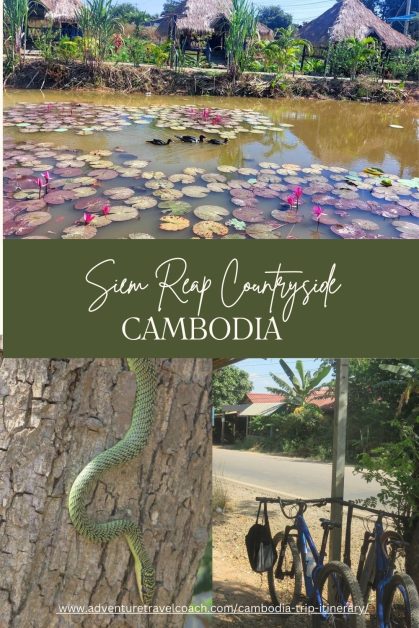
- If you are comfortable staying in hostel dorms in Cambodia, you can expect to spend around $8-10 per day for dorms and $10-$20 for private rooms, depending on the region.
- Mid-range accommodation or a guest house will cost around $20 per day.
- A double room with an ensuite bathroom in a guesthouse or hotel is about $20-25.
- Upmarket hotels with a swimming pool and an on-site restaurant will cost between $25-35.
- If you prefer more comfortable accommodation and want to indulge in luxury food, budget around $40 daily. Cities like Phnom Penh and Siem Reap have a broader spectrum of luxurious accommodation options.
- Hotels that offer luxurious amenities such as a swimming pool and on-site restaurant typically charge between $25 and $35 per night.
Food in Cambodia is relatively inexpensive. You can enjoy street food for as little as $1 to $2. A meal at a mid-range restaurant costs between $3 and $8, and a gourmet meal can cost up to $15. Remember, this all depends on what you eat. Beer is cheaper than water; one can enjoy an ice-cold draft for as little as $1. With the heat and vibe, you’ll surely enjoy many ice-cold Cambodian beers.
Transport
Motorcycle taxis: $1 or less
Rework-moto or tuk-tuk @ $1-$5 depending on distance
Buses: Trips to and from major cities in Cambodia – Siem Reap to Phnom Penh @ $10
Cambodia Health and Safety Tips
Cambodia is a relatively safe country, so one must always be conscious of one’s surroundings. After three decades of war, there are still unexploded ordnance and landmines in some rural areas of Cambodia. Fortunately, the number of landmine victims is decreasing yearly thanks to Apopo and their intelligent rodents. For more info on Apopo and how to watch these heroes, visit Holidays in Cambodia.
Cambodia safety travel tips to keep you safe and well and ensure a memorable Vacation in Cambodia:
- Keep your Travel Insurance documents with you at all times.
- Ensure your documents and passport are safely locked at your accommodation.
- Wear a money- and RDIF protection bag or purse to keep money and credit cards safe.
- Keep the following Emergency contact numbers close: Police: 117, Medical emergencies: 119, Fire & Rescue: 118
What not to do in Cambodia
- Do not wander off a path or the road when walking or cycling.
- Never travel without travel insurance that provides coverage for whatever may happen.
- Do not wear expensive jewellery or flash around valuables.
- Avoid walking alone at night, and stay away from dark alleys.
- Do not leave your bag and valuables unattended.
- Be aware of your drink when visiting bars.
- Always be aware of your surroundings and ensure you don’t get distracted wherever you are.
- Beware of bag snatchers who mostly travel on motorbikes and target pedestrians and people in open tuk-tuks.
Is Cambodia safe for female travellers? Yes! Cambodia is generally a very safe country, even for solo female travellers.
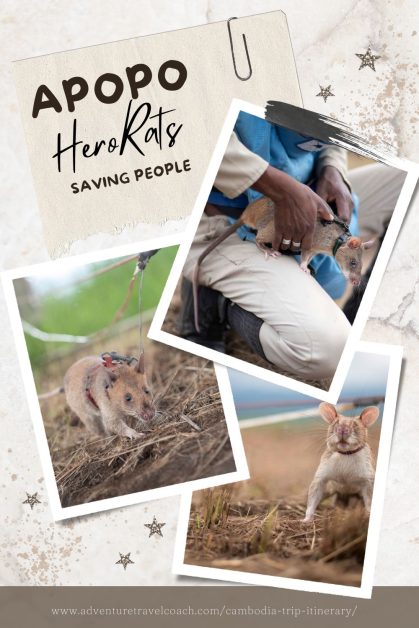
Visit reliable Safetywing and World Nomad Travel Insurance for Cambodia Travel Insurance quotes.
Vaccines for Cambodia
- Hepatitis A is passed through contaminated food or water.
- Typhoid vaccine is available if you are travelling to rural areas, as well as for adventurous eaters.
- Hepatitis B can be contracted through sexual contact, exposure to bodily fluids, or piercing.
- Malaria is present in many areas of Cambodia, particularly around Myanmar, Laos and Thailand. We took various vaccines and anti-malaria pills, although I’m not even sure if that is such a risk.
- Dengue fever and Japanese encephalitis are recommended if you visit rural areas, go hiking, or stay for more than 30 days in the Country.
Food in Khmer
Cambodian cuisine combines culinary traditions from various ethnic groups, including Indian, Chinese, Portuguese, and French cuisine. Although Khmer dishes are less well-known than those of its neighbouring countries, Cambodian cuisine is equally healthy, flavorful, and delicious. Due to shared influences, it has many similarities but is uniquely different.
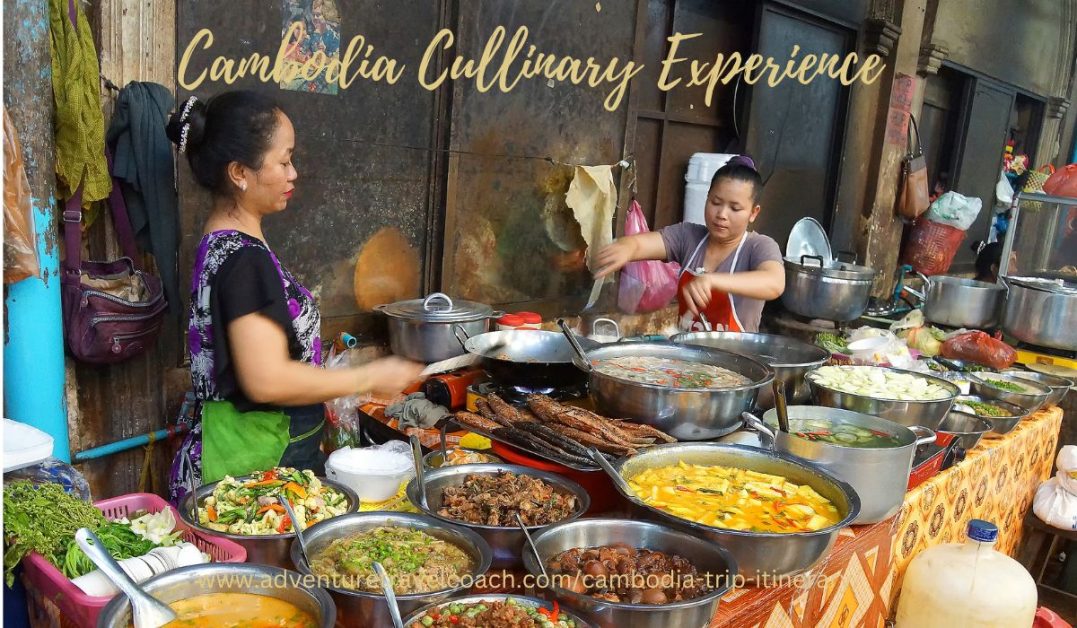
Cambodian traditional cuisine offers flavourful dishes ranging from curries, soups, and noodles to bits and pieces of grilled and fried foods.
For the best cultural experience, book one of the food tours and a Cambodian cooking class to taste various dishes. With so many fantastic flavours and foods, a great food tip and what to eat in Cambodia is by booking a food tour.
Cambodian food is extraordinary and also very cheap at the markets. Try a crispy Tarantula or other interesting treats if you’re feeling adventurous.
Markets in Cambodia
The Popular Russian Market, Central Market, and BKK1 Market in Phnom Penh sell clothes, souvenirs, music and DVDs, household goods, and even vehicle parts. Siem Reap’s hot spots are the Angkor Night Market and the Old Market. One of the Best Cambodia Shopping Tips: If you want a bargain, arrive at the market early, as Khmers believe their first successful sale will bring them luck. Therefore, your chances of getting a good deal are early in the day.
Cambodia Shopping Tips
Haggle in Cambodia is essential and expected by Khmers. Buy yourself a Krama soon after your arrival. The traditional Cambodian scarf or bandanna has multiple purposes. You can wear a Krama to protect you from the sun, wind, or rain and a quick cover-up around your shoulders, hips, or neck. It is pronounced krɒˈmɑ, or in Khmer, ក្រមា.
Things to buy in Cambodia: Shopping in Cambodia can be overwhelming, with items varying from clothing, silver jewellery, and trinkets to handmade natural organic products, spices and foods.
Cambodia Interesting Facts
- Labour: Cambodia’s labour force works in subsistence agriculture, with rice farming, tourism, and the textile industry as the primary income sources.
- Birthday celebrations: Cambodians don’t usually celebrate birthdays. Instead, friends will gather with some beer, their drink of choice.
- Cambodia’s traditional attire is worn throughout the year. On special occasions, people wear outfits that are easy to notice due to their bright colours and intricate designs. Much traditional wear is made from golden silk, featuring unique patterns and designs specific to Cambodia.
- Popiah is a local greeting Khmers use when introducing new friends. It involves putting your hands together like in a prayer. When beckoning someone, remember to wave towards yourself with your palm down.
- Cambodia’s National Animal is the Kouprey (forest ox), a possibly extinct forest-dwelling wild bovine (water buffalo) native to Southeast Asia.
- The Mekong River originates from the Lasagongma Spring, located at an altitude of over 17,000 feet above sea level on the slopes of Mount Guozongmucha in the Tibetan Plateau of China.
- Cambodia’s primary natural freshwater sources are the Mekong River and the Tonle Sap Lake.
- The Tonlé Sap is the largest freshwater lake in Southeast Asia. As one of the world’s most diverse and productive ecosystems, it was designated a Biosphere Reserve by UNESCO in 1997.
- During the Monsoon season, Tonle Sap floods approximately 16,000 square kilometres of the Country, providing irrigation for rice fields and breeding grounds for fish. During the monsoon season, the Mekong River overflows, leading to the water backing up the Tonle Sap River and reversing its flow. More than 500,000 tons of fish come out of the Tonle Sap each year.
Cambodia Packing List
Tips on What to Wear in Cambodia
- Pack casual lightweight gear and a dry-mag or light rain jacket.
- Lightweight, loose-fitting casual clothes, like cotton and linens, are the best to combat the humidity.
- Casual sandals, comfortable walked-in sturdy shoes and flip flops.
- Cover your knees and shoulders when entering temples and other sacred sites. Tip: I carry a scarf or sarong in my day-pack.
- Pack a warm top for unforeseen cool nights, especially when you decide to travel Northeast between November and March.
- There is no need to dress unless you want to hang out at high-end bars and clubs in Phnom Penh and Siem Reap.
- Day-pack and a Refillable water bottle. However, water is very cheap and available everywhere.
- You can buy a Cambodian SIM card for your mobile phone at the airport or a store.
- Powerful sunscreen and long-lasting deodorant.
- Sunhat, sunglasses and a light raincoat.
- Earplugs to block out the noise.
Travelling to Cambodia and Vietnam on the same trip is an excellent idea. Also, check out the Top Reasons to Explore Cambodia.
For an even greater experience, combine your trip and check out our amazing trip around Vietnam.

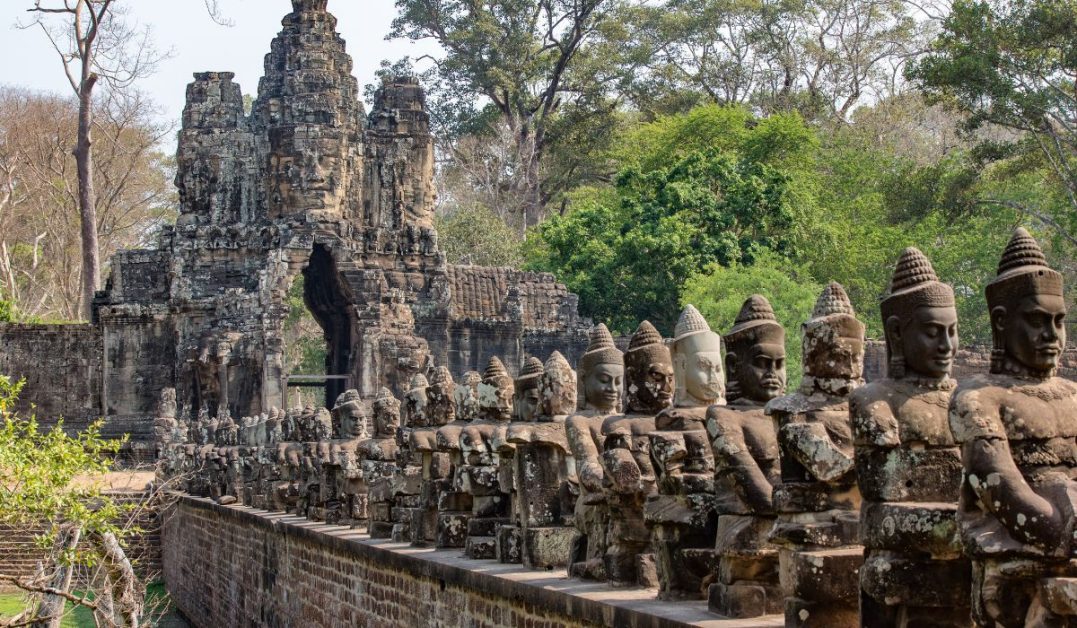
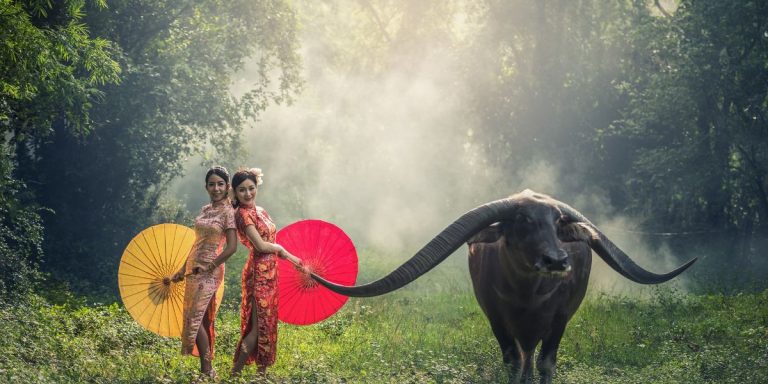
Defenitely a unique experience, but so is the rest of Vietnam.
sounds liked a must visit